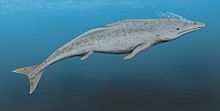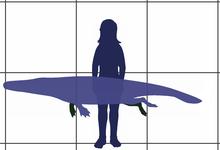| Protocetus | |
|---|---|
 | |
| Underside of a skull cast at the Museum für Naturkunde, Berlin | |
| Scientific classification | |
| Kingdom: | Animalia |
| Phylum: | Chordata |
| Class: | Mammalia |
| Order: | Artiodactyla |
| Infraorder: | Cetacea |
| Family: | †Protocetidae |
| Genus: | Protocetus |
| Species: | P. atavus |
| Binomial name | |
| Protocetus atavus | |
Protocetus atavus ("first whale") is an extinct species of primitive cetacean from Egypt. It lived during the middle Eocene period 45 million years ago. The first discovered protocetid, Protocetus atavus was described by Fraas 1904 based on a cranium and a number of associated vertebrae and ribs found in middle Lutetian Tethyan marine limestone from Gebel Mokattam near Cairo, Egypt.[1]
Description
Protocetus are believed to have had a streamlined, whale-like body around 2.5 metres (8.2 ft) long, but was probably primitive in some respects.[2]
Many protocetids (like Maiacetus, Rodhocetus) possessed well developed innominates and hind limbs, often attached to the backbone with a sacrum. Protocetus are known to have had at least one sacral vertebrate,[3] and likely possessed hind limbs and webbed toes.[2] The shape of the bones in the tails suggests that it may have had a tail fluke like modern whales.
The head of Protocetus measured about 0.6 meters long.[4] The jaws were long and lined with sharp teeth. While it did not have a true blowhole, the nostrils were placed further back on the head than in most land mammals.[2] Unlike the more primitive Pakicetus, the structure of the ears suggests that Protocetus was able to hear properly underwater, although it is unlikely that it could echolocate. Similarly, it retained sufficient olfactory apparatus to have a good sense of smell, although it probably relied more on its eyesight to find prey.[2]
See also
References
Notes
- ^ Bianucci & Gingerich 2011, p. 1174
- ^ a b c d Palmer D (ed.) (1999). The Marshall Illustrated Encyclopedia of Dinosaurs and Prehistoric Animals. London: Marshall Editions. p. 230. ISBN 978-1-84028-152-1.
- ^ Gingerich P.D. (2010). "Cetacea". In Werdelin L & Sanders W.J. (eds.). Cenozoic mammals of africa. Berkeley: University of California Press, p. 873–899
- ^ Gingerich, Philip D.; Arif, Muhammad; Clyde, William C. (1995). "New Archaeocetes (Mammalia, Cetacea) from the middle Eocene Domanda Formation of the Sulaiman Range, Punjab (Pakistan)". Contributions from Museum of Paleontology, the University of Michigan. 29 (11): p. 291–330
Sources
- Fraas, Eberhard (1904). "Neue Zeuglodonten aus dem unteren Mitteleocän vom Mokattam bei Cairo". Geologische und Paläontologische Abhandlungen. 6 (3): 199–220. Retrieved July 2013.
- Bianucci, Giovanni; Gingerich, Philip D. (2011). "Aegyptocetus tarfa, n. gen. et sp. (Mammalia, Cetacea), from the middle Eocene of Egypt: clinorhynchy, olfaction, and hearing in a protocetid whale". Journal of Vertebrate Paleontology. 31 (6): 1173–1188. doi:10.1080/02724634.2011.607985.

